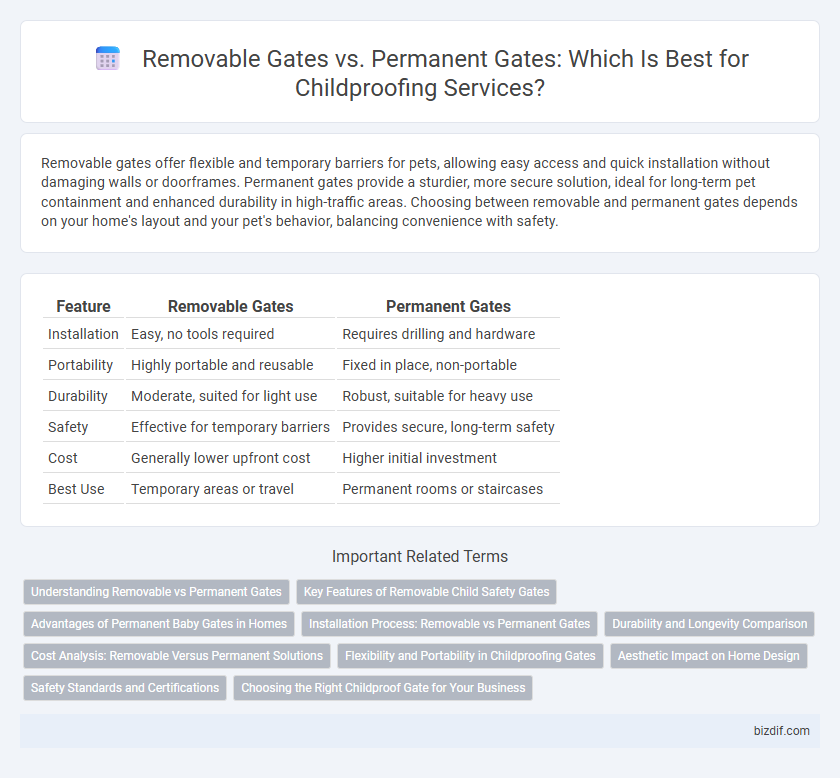Removable gates offer flexible and temporary barriers for pets, allowing easy access and quick installation without damaging walls or doorframes. Permanent gates provide a sturdier, more secure solution, ideal for long-term pet containment and enhanced durability in high-traffic areas. Choosing between removable and permanent gates depends on your home's layout and your pet's behavior, balancing convenience with safety.
Table of Comparison
| Feature | Removable Gates | Permanent Gates |
|---|---|---|
| Installation | Easy, no tools required | Requires drilling and hardware |
| Portability | Highly portable and reusable | Fixed in place, non-portable |
| Durability | Moderate, suited for light use | Robust, suitable for heavy use |
| Safety | Effective for temporary barriers | Provides secure, long-term safety |
| Cost | Generally lower upfront cost | Higher initial investment |
| Best Use | Temporary areas or travel | Permanent rooms or staircases |
Understanding Removable vs Permanent Gates
Removable gates offer flexible installation options and easy removal for temporary use, making them ideal for parents who need adaptable solutions to block off hazardous areas. Permanent gates provide a sturdier, more secure barrier anchored to walls or door frames, ensuring long-term safety in high-risk zones such as staircases. Understanding the differences in stability, installation, and versatility helps caregivers select the most appropriate gate to effectively childproof their home environments.
Key Features of Removable Child Safety Gates
Removable child safety gates offer portability and easy installation without tools, making them ideal for temporary use in multiple locations. Key features include lightweight design, pressure-mounted mechanisms that prevent damage to walls, and quick-release latches for convenient opening and closing. These gates provide flexible boundary control while maintaining safety standards for toddlers and pets.
Advantages of Permanent Baby Gates in Homes
Permanent baby gates offer enhanced stability and security, making them ideal for high-traffic areas or staircases where safety is paramount. Their robust installation minimizes the risk of accidental dislodging, providing consistent protection against falls and restricted access. These gates often feature durable materials that withstand wear and tear, ensuring long-term safety solutions within homes.
Installation Process: Removable vs Permanent Gates
Removable gates offer a quick and straightforward installation process, often using pressure-mounted systems that require no drilling or hardware, ideal for renters or temporary setups. Permanent gates involve a more complex installation, typically requiring drilling into walls or banisters to securely affix hardware, ensuring maximum stability for long-term use. Choosing between removable and permanent gates depends on the need for mobility versus durability in childproofing spaces.
Durability and Longevity Comparison
Removable gates offer convenience and flexibility but typically lack the durability of permanent gates, which are built with sturdier materials designed to withstand long-term use. Permanent gates provide enhanced longevity by securely attaching to walls or door frames, reducing the risk of wear and tear over time. For high-traffic areas where durability is critical, permanent gates are generally the better investment for effective childproofing.
Cost Analysis: Removable Versus Permanent Solutions
Removable gates typically offer a lower upfront cost and greater flexibility, making them a budget-friendly choice for families needing temporary childproofing solutions. Permanent gates generally require professional installation, leading to higher initial expenses but providing enhanced durability and long-term safety. Evaluating the cost-effectiveness involves balancing installation fees, maintenance expenses, and the gate's lifespan based on household needs.
Flexibility and Portability in Childproofing Gates
Removable gates offer superior flexibility and portability, allowing parents to easily relocate or adjust barriers as their child's needs change. Permanent gates provide a fixed, sturdy solution but lack the adaptability for different spaces or temporary uses. Choosing removable gates enhances convenience in dynamic environments, ensuring effective childproofing without compromising on ease of installation or movement.
Aesthetic Impact on Home Design
Removable gates offer flexibility and minimal disruption to interior design, blending seamlessly with various home styles without altering structural elements. Permanent gates, while providing robust safety, can significantly impact the aesthetic by introducing fixed fixtures that may clash with existing decor. Choosing between removable and permanent gates involves balancing safety needs with maintaining the visual harmony of your living space.
Safety Standards and Certifications
Removable gates offer flexibility and ease of installation but must meet rigorous safety standards such as ASTM F1004 and JPMA certification to ensure they securely contain children without risk of collapse or entrapment. Permanent gates, typically mounted with hardware, provide enhanced stability and often comply with stricter building code requirements, including ASTM F1004 and EN 1930 certifications, guaranteeing long-term safety in high-traffic areas. Choosing gates that adhere to recognized safety certifications ensures maximum protection and peace of mind in childproofing environments.
Choosing the Right Childproof Gate for Your Business
Selecting the right childproof gate for your business depends on the environment's flexibility and safety requirements. Removable gates offer convenience and mobility, ideal for temporary setups or spaces where frequent changes occur, while permanent gates provide robust security and durability for consistent, high-traffic areas. Evaluating factors such as installation surface, anticipated usage frequency, and compliance with safety standards ensures optimal childproofing tailored to your commercial needs.
Removable gates vs Permanent gates Infographic

 bizdif.com
bizdif.com